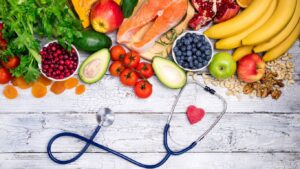We all know someone who seems able to eat whatever they want without gaining weight. It can feel unfair, especially if you’re someone who eats well, stays active, and still struggles to lose those last few kilos.
However, appearing slim doesn’t always mean being healthy. It’s possible to have a normal body weight but still have a high amount of internal body fat. This is called normal-weight obesity — and research suggests it can carry health risks similar to those of obesity.
What is normal-weight obesity?
People with normal-weight obesity have a body mass index (BMI) in the normal range but an elevated body fat percentage. Excess fat, particularly in the abdominal area, can increase the risk of developing conditions like metabolic syndrome, high blood pressure, heart disease, and type 2 diabetes.
Another related condition is central obesity, which refers to fat stored deep inside the abdomen, surrounding internal organs. This type of fat — called visceral fat — is particularly concerning because it can affect metabolism and increase inflammation, even in people who don’t appear overweight externally.
Visceral fat releases inflammatory compounds and fatty acids into the bloodstream, which can disrupt normal metabolic processes. Unlike subcutaneous fat (the soft fat just under the skin), visceral fat has more harmful effects on health.
5 signs you could be “skinny fat”:
- Carrying extra fat around your midsection
- High blood pressure
- Elevated cholesterol levels
- Insulin resistance or high blood glucose levels
- Limited physical activity and unbalanced eating habits
How common is it?
Studies suggest that normal-weight obesity is becoming more common. Australian data has shown that, for people of the same weight and height, average waist circumference increased by several centimetres over recent decades. This means more people are carrying unhealthy amounts of visceral fat, even if their BMI appears normal.
Why it matters
People with normal BMIs but larger waist measurements are at greater risk of developing conditions like cardiovascular disease, diabetes, and hypertension. This is because fat around internal organs produces hormones and proteins that can cause inflammation, disrupt insulin regulation, and affect appetite control. These effects make it harder for the body to maintain a healthy metabolic balance.
What causes it?
Genetics play a role, as some people are naturally predisposed to store fat in the abdominal region. However, lifestyle factors such as inactivity, poor diet, and stress also contribute. As we age, muscle mass naturally declines — especially without regular resistance training — and this loss can slow metabolism and increase body fat percentage over time. Hormonal changes, such as those occurring during menopause, also tend to shift fat storage toward the abdomen.
Chronic stress may also increase cortisol levels, a hormone linked to abdominal fat storage. Combined with less activity and unbalanced eating habits, this can make normal-weight obesity more likely to develop.
How do I know if I have it?
Since weight alone doesn’t always tell the full story, analysing your body composition can help. This can be done through bioelectrical impedance testing, available in some gyms, clinics, and pharmacies. These assessments measure fat and muscle percentages to give a clearer picture of overall health.
You can also look for signs such as increased waist circumference or central fat storage. Individuals with an “apple” body shape (more fat around the middle) are typically at greater risk than those with a “pear” shape (more fat on the hips and thighs).
Speak to your doctor
Regular check-ups, including cholesterol, glucose, and blood pressure tests, can help identify early warning signs of metabolic changes. These indicators provide a more complete understanding of your health than weight alone.
Measure your waist
A simple waist measurement can help estimate visceral fat levels. Measure around your abdomen at the level of your belly button — not where your belt sits. A waist size above 94 cm for men or 80 cm for women may indicate a higher health risk.
How to reduce normal-weight obesity
The good news is that visceral fat responds well to lifestyle changes. Combining regular physical activity with a nutritious diet can help reduce internal fat and improve overall health. Here are some practical steps:
1. Focus on nutrition
Prioritise whole, minimally processed foods — such as vegetables, fruits, lean proteins, and whole grains — while limiting refined carbohydrates, added sugars, and saturated fats. Keep portions balanced and aim for half your plate to be filled with vegetables. Reducing alcohol and sugary drinks can also help, as high sugar intake is associated with increased visceral fat.
2. Move daily
Regular exercise is one of the most effective ways to reduce visceral fat. Aim for at least 30 minutes of moderate activity each day, such as walking, cycling, swimming, or dancing.
3. Strength training
Building muscle through resistance training boosts metabolism and helps reduce fat, including visceral fat. Stronger muscles also support bone health and mobility, particularly as you age.
4. Manage stress
Chronic stress raises cortisol levels, which can contribute to abdominal fat storage. Regular relaxation techniques — such as meditation, deep breathing, or yoga — can help maintain a healthier balance.
5. Prioritise sleep
Aim for consistent, good-quality sleep. Poor sleep patterns are linked to higher appetite, cravings for high-calorie foods, and a greater risk of metabolic issues such as diabetes and heart disease.
Risks and Recovery
Normal-weight obesity can increase the risk of serious health problems, but it’s reversible with the right approach. Lifestyle changes — including balanced nutrition, regular exercise, and adequate rest — can reduce visceral fat and improve long-term health outcomes. As individual results vary, it’s important to seek professional guidance from your healthcare provider before starting a new exercise or dietary plan, especially if you have existing medical conditions.
“



